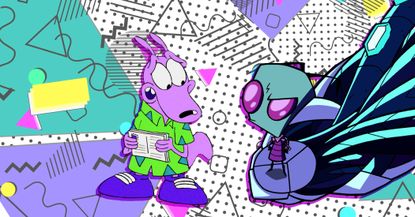The persistent relevance of Rocko's Modern Life and Invader Zim
Netflix's duel Nickelodeon revivals show how much our world has changed — and how much it hasn't


In the 1990s through the early aughts, Nickelodeon, a kids' TV network known for such millennial classics as Rugrats, Doug, and Hey Arnold, was also host to more controversial animated fare. Not as wholesome or family-targeted as their go-tos, these series were crass, sometimes disgusting, and used more adult humor to toy with darker themes.
Two of those shows, Rocko's Modern Life, and Invader Zim, which both returned this month in the form of movie-length Netflix specials, used exactly this style of gross-out humor to carry an innovative brand of satire. Both series served as precursors to popular animated series today, and though they take different approaches to the time that has passed since their original runs, both reboots serve as a testament to just how insightful and prescient they were in their time.
Rocko's Modern Life premiered in 1992, a brightly colored show teeming with loud, blown-out physical gags and mentally unstable anthropomorphized animals a la The Ren & Stimpy Show. But where Ren & Stimpy had a truly absurdist spin, Rocko's Modern Life was always a zonked-out parody of a sitcom about contemporary American life. Rocko, a wallaby, is the everyman who, along with his stupid bovine friend, Heifer, and anxious turtle friend, Filbert, gets caught up in the tricky affairs of modern living. But the majority of his problems are rooted in larger societal ones.
Subscribe to The Week
Escape your echo chamber. Get the facts behind the news, plus analysis from multiple perspectives.

Sign up for The Week's Free Newsletters
From our morning news briefing to a weekly Good News Newsletter, get the best of The Week delivered directly to your inbox.
From our morning news briefing to a weekly Good News Newsletter, get the best of The Week delivered directly to your inbox.
Rocko's world is owned by Conglom-O, an aptly named avatar of capitalism that owns practically everything in Rocko's town, and, by extension, its people. (Its slogan: "We own you.") In one episode from the mid-'90s, before the threat of environmental catastrophe seemed as imminent as it does now, Rocko and the other citizens of his town try to take on Conglom-O—in musical form — to get the corporation to safely dispose of its waste and recycle. When Rocko's miserable neighbor, Ed Bighead, a Conglom-O employee, scoffs at all of the green talk and sprays an aerosol can up at the ozone layer, it degrades, letting enough sunlight come through to burn him to a crisp.
The show loved to jeer at the evil work of corporations and their henchmen, but its satire also ran deeper, to a critique of a general erosion of American values — or perhaps a distrust of them to begin with. Though Rocko's Modern Life was full of racy jokes and bodily mutilation, causing the network to censor some of its more controversial choices, its main criticism was the American tendency for excess. The animal folks of O-Town are greedy, gluttonous and lustful, and even Rocko becomes corrupted at times, falling into traps of consumerism while shopping or, succumbing to the allure of power, transforming into a merciless, cigar-smoking boss. In Rocko's Modern Life, every character is weak with some vice or another, and no one goes unharmed for it.
In 2001, five years after the end of Rocko's Modern Life, a new series by the comic book writer Jhonen Vasquez, Invader Zim, premiered. Unlike the bright shapes and rounded character styles of Rocko's world, Invader Zim sported a much bleaker design aesthetic, full of sharp angles and jagged lines. Characters were either scrawny and gaunt, with creepy branchlike appendages, or obese — sloppy and misshapen. The colors were gothic, full of blacks and greys and dark violets. And the characters were stupid and strange. In the series, an incompetent alien invader named Zim comes to earth with his hilariously inane robot sidekick, Gir, to take over the planet, while a preteen conspiracy-theorist, Dib, tries to stop him.
Though not as pointedly anti-establishment as Rocko's Modern Life, Invader Zim shared a similarly cynical outlook on humanity. The dark world of the show — one in which children's organs are harvested and characters are transformed into meat — is one ruled by petty distractions: video games (the sole hobby of Gaz, Dib's antisocial sister); odd, nonsensical TV shows ("The Scary Monkey Show," one of Gir's favorites); and disgusting fast-food places (Bloaty's Pizza Hog, somehow more disgusting than Chokey Chicken, the king restaurant chain in Rocko's Modern Life). In the world of Invader Zim, we're all easily duped and easily distracted, and because of that, as Gir would say, in high-pitched song, we're all doomed.
Sign up for Today's Best Articles in your inbox
A free daily email with the biggest news stories of the day – and the best features from TheWeek.com
In the years since Rocko's Modern Life and Invader Zim ended, plenty of other animated series have seemed to take inspiration from the two series. The recent Netflix series Tuca and Bertie seemed to draw from Rocko's playful aesthetic, from its anthropomorphized animals living a quirky version of contemporary life to its surreal touches — inanimate objects suddenly bopping and dancing with life. And it's hard to imagine Rick and Morty, with its cynical jokes, obscene body humor and sci-fi premise, without Invader Zim. (Rick and Morty co-creator Justin Roiland even lends his voice talents to the new Invader Zim movie.)
The Netflix revivals of the two shows are touched with a palpable sense of nostalgia. Invader Zim: Enter the Florpus picks up pretty much where the show left off, like an hour-long episode of the original series, but one that's often softened around the edges. Zim has reappeared after a period of absence, and it's business as usual: one stupid plan leads to another, which leads to the transportation of earth to another part of the galaxy, causing a rift in space that warps the borders of alternative realities. There are the same trusty landmarks of the original series: the ignorance of Dib's father, threats from Gaz, lots of screaming, and a song from Gir. Enter the Florpus pretty much disregards the years passed between its release and the end of the original series, passing over any opportunities for its signature bite in favor of a safer, more clean-cut update, where even the animation style on the Netflix special looks cleaner and glossier than that of the original. There's only the smallest hint of the show's old wry, critical sense of humor, when Zim nearly wins by selling a bunch of high-tech bracelets that he manipulates with his alien technology, offering them, to enthusiastic applause, in four different colors. "All this time trying to subjugate the humans, and all I had to do was charge them for it!" he declares to Gir, as consumerism nearly destroys the world.
If Enter the Florpus tries to act as though no time has passed, Rocko's Modern Life: Static Cling takes that change as its central conceit. After Rocko, Heifer, and Filbert return from being stuck in space for 20 years, they try to adjust to a new definition of "modern life," but Rocko finds that adjustment difficult, and seeks the one thing that will make him feel at home: episodes of his favorite show, The Fatheads. The theme song of Static Cling is redone with careful attention to the original gags, now updated to the times. The trio fills up on caffeine at a Buzzbucks cafe, just to do the same thing at another Buzzbucks a few feet away; then they get the new O-phone and glut themselves at a food truck with "pizza tacos." Rocko is attacked by a rogue cursor, a carnivorous laptop surveillance camera, and more. Change is overwhelming, is what Static Cling seems to say, but it also shows what good can come with it.
Static Cling made the monumental choice to portray one of the show's characters, Ralph Bighead, the son of Rocko's neighbors, as transgender. She's now Rachel, she says to Rocko and his friends, and they respond with understanding and acceptance — "Wow, cool," "That is awesome!" — before continuing, as though it were the most obvious thing in the world. By the end of "Static Cling," the evil Conglom-O (whose motto is now "We own squat") has been launched into space, and even the most stubborn and disagreeable characters have been convinced to move on.
Other than that moment of radical inclusion, however, "Static Cling" doesn't have much specifically to say about how our culture has changed in the nearly three decades since its premiere. Sure, new technology is overwhelming, but the true antagonistic force is the push-pull of changing times and one's constant adjustments to them.
As bold and innovative as Rocko's Modern Life and Invader Zim were when they first aired, the reboots can't touch that, nor do they need to. Rather, the new specials serve as a means for fans to step back into the realms of those shows, with their dark freakish and wayward takes on society, and reflect on just how much things have changed in their own world.
Create an account with the same email registered to your subscription to unlock access.
Maya Phillips is an arts, entertainment, and culture writer whose writing has appeared in The New York Times, Vulture, Slate, Mashable, American Theatre, Black Nerd Problems, and more. She is also a web producer at The New Yorker, and her debut poetry collection, Erou, is forthcoming in fall 2019 from Four Way Books. She lives in Brooklyn.
-
 Cicada-geddon: the fungus that controls insects like 'zombies'
Cicada-geddon: the fungus that controls insects like 'zombies'Under The Radar Expert says bugs will develop 'hypersexualisation' despite their genitals falling off
By Chas Newkey-Burden, The Week UK Published
-
 'Voters know Biden and Trump all too well'
'Voters know Biden and Trump all too well'Instant Opinion Opinion, comment and editorials of the day
By Harold Maass, The Week US Published
-
 Is the Gaza war tearing US university campuses apart?
Is the Gaza war tearing US university campuses apart?Today's Big Question Protests at Columbia University, other institutions, pit free speech against student safety
By Joel Mathis, The Week US Published